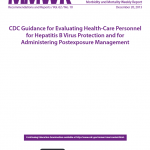CDC Guidance for Evaluating Health-Care Personnel for Hepatitis B Virus Protection and for Administering Postexposure Management
Auteur 1National Center for HIV/AIDS, Viral Hepatitis, STD, and TB Prevention, CDC
Volume 62
Numéro RR-10
Pages 1-19
Publication MMWR. Recommendations and reports: Morbidity and mortality weekly report. Recommendations and reports / Centers for Disease Control
Date Dec 20, 2013
Résumé This report contains CDC guidance that augments the 2011 recommendations of the Advisory Committee on Immunization Practices (ACIP) for evaluating hepatitis B protection among health-care personnel (HCP) and administering post-exposure prophylaxis. Explicit guidance is provided for persons working, training, or volunteering in health-care settings who have documented hepatitis B (HepB) vaccination years before hire or matriculation (e.g., when HepB vaccination was received as part of routine infant [recommended since 1991] or catch-up adolescent [recommended since 1995] vaccination). In the United States, 2,890 cases of acute hepatitis B were reported to CDC in 2011, and an estimated 18,800 new cases of hepatitis B occurred after accounting for underreporting of cases and asymptomatic infection. Although the rate of acute hepatitis B virus (HBV) infections have declined approximately 89% during 1990-2011, from 8.5 to 0.9 cases per 100,000 population in the United States, the risk for occupationally acquired HBV among HCP persists, largely from exposures to patients with chronic HBV infection. ACIP recommends HepB vaccination for unvaccinated or incompletely vaccinated HCP with reasonably anticipated risk for blood or body fluid exposure. ACIP also recommends that vaccinated HCP receive postvaccination serologic testing (antibody to hepatitis B surface antigen [anti-HBs]) 1-2 months after the final dose of vaccine is administered (CDC. Immunization of health-care personnel: recommendations of the Advisory Committee on Immunization Practices [ACIP]. MMWR 2011;60 [No. RR-7]). Increasing numbers of HCP have received routine HepB vaccination either as infants (recommended since 1991) or as catch-up vaccination (recommended since 1995) in adolescence. HepB vaccination results in protective anti-HBs responses among approximately 95% of healthy-term infants. Certain institutions test vaccinated HCP by measuring anti-HBs upon hire or matriculation, even when anti-HBs testing occurs greater than 2 months after vaccination. This guidance can assist clinicians, occupational health and student health providers, infection-control specialists, hospital and health-care training program administrators, and others in selection of an approach for assessing HBV protection for vaccinated HCP. This report emphasizes the importance of administering HepB vaccination for all HCP, provides explicit guidance for evaluating hepatitis B protection among previously vaccinated HCP (particularly those who were vaccinated in infancy or adolescence), and clarifies recommendations for postexposure management of HCP exposed to blood or body fluids.
Chercher cette référence sur : Google Scholar, Worldcat
Laisser une réponse
Vous devez etre connectez Pour poster un commentaire









